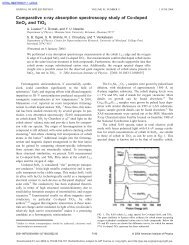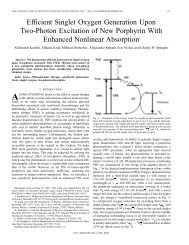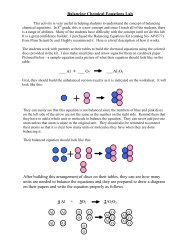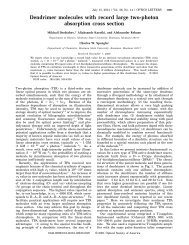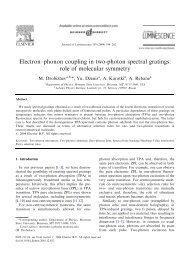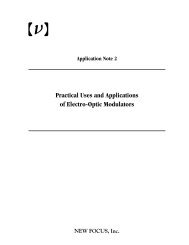Defects in inorganic photorefractive materials and their investigations
Defects in inorganic photorefractive materials and their investigations
Defects in inorganic photorefractive materials and their investigations
You also want an ePaper? Increase the reach of your titles
YUMPU automatically turns print PDFs into web optimized ePapers that Google loves.
<strong>Defects</strong> <strong>in</strong> <strong>in</strong>organic <strong>photorefractive</strong> <strong>materials</strong> <strong>and</strong> <strong>their</strong> <strong>in</strong>vestigations 27<br />
Fig. 13. Spectroscopic model<br />
for sillenite crystals. The notation<br />
0-4 for the various absorption<br />
processes is the same as that used<br />
<strong>in</strong> figure 11.<br />
2.2 eV at room temperature <strong>in</strong>dicates the thermal energy of the Bi 3+/4+<br />
M<br />
level<br />
with respect to the conduction b<strong>and</strong>. The ionized electron is then trapped at<br />
one of the donor states D + , which are all empty before, <strong>and</strong> the paramagnetic<br />
D 0 is formed. Photoabsorption <strong>and</strong> photo-MCD experiments have shown that<br />
the b<strong>and</strong>s <strong>in</strong> the visible region can be partly bleached at low temperature by<br />
a further illum<strong>in</strong>ation either at 1.5 eV (800 nm) or, more effectively, at 2.2 eV<br />
(560 nm). In the first <strong>in</strong>stance, the electron ionized from the D 0/+ level is<br />
trapped at the Bi 3+/4+<br />
M<br />
level. In the second process, electrons are excited<br />
from the valence b<strong>and</strong> to the Bi 3+/4+<br />
M<br />
level.<br />
B<strong>and</strong> ’1’ <strong>in</strong> the MCD <strong>and</strong> absorption spectra (colored state) is assigned<br />
[153] to the ionization of an electron from the Bi 4+/5+<br />
M<br />
level to the conduction<br />
b<strong>and</strong>, i.e. to the second ionization of the antisite defect. This is supported<br />
by the follow<strong>in</strong>g observations: 1) as shown by ODMR, the <strong>in</strong>itial state of the<br />
transition is the Bi 4+<br />
M<br />
state; 2) the b<strong>and</strong> does not occur under strong acceptor<br />
(e.g. Al) dop<strong>in</strong>g. This removes all Bi 4+<br />
M<br />
charge states. S<strong>in</strong>ce the Al3+/4+<br />
Si<br />
level<br />
was shown earlier, us<strong>in</strong>g thermal bleach<strong>in</strong>g studies [150], to lie at most 0.5 eV<br />
above the valence b<strong>and</strong>, one has to conclude that the Al 3+/4+<br />
Si<br />
level lies below<br />
the Bi 4+/5+<br />
M<br />
level, as shown <strong>in</strong> Fig. 13. The position of the former at about E C<br />
- 2.7 eV at 4.2 K is taken from the onset of b<strong>and</strong> ’1’. F<strong>in</strong>ally, the broad MCD<br />
<strong>and</strong> optical absorption features ’4’ <strong>and</strong> ’5’ were tentatively assigned [146] to<br />
oxygen vacancies.<br />
Fig. 11 shows that b<strong>and</strong>s ’2’ <strong>and</strong> ’3’ dom<strong>in</strong>ate the optical absorption <strong>in</strong><br />
the colored state. As shown above, they are caused by electron excitation<br />
from the valence b<strong>and</strong> to Bi 4+<br />
M<br />
or, alternatively, to the excitation of the Bi4+<br />
M<br />
hole to the valence b<strong>and</strong>. A hole at one of the tetrahedral oxygen ions next<br />
to Bi 3+<br />
M<br />
represents a small hole polaron bound <strong>in</strong> tetrahedral symmetry [11].<br />
By the self-localization at one oxygen site the symmetry is lowered to trigonal.<br />
It is a natural consequence [11, 158] of such a system that its optical<br />
absorption consists of two strong, equally wide b<strong>and</strong>s of nearly identical <strong>in</strong>tensities,<br />
separated by some tenths of an eV. One of the two excited states is





